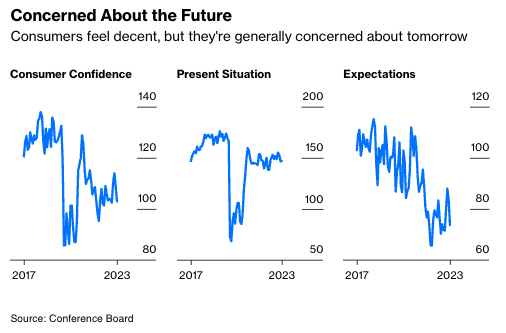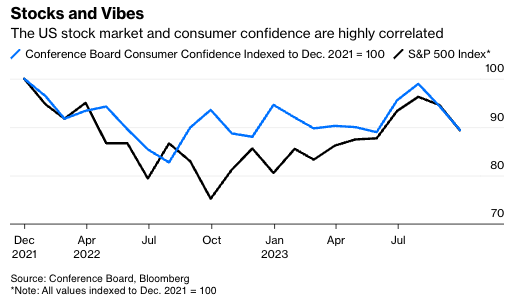The U.S. may be heading back into a “vibecession”—a condition in which consumer confidence and other economic “vibes” decline so much that they threaten to become self-fulfilling prophecies and drag the economy down with them.
Content creator (and Bloomberg Opinion contributor) Kyla Scanlon coined the term last year to describe the weird environment in which the U.S. found itself, but by mid-summer this year, a variety of gauges suggested that confidence had bounced back. At the time, I wrote that the vibecession was over, and Scanlon generally agreed. Unfortunately, some preliminary signs are indicating that we’re backsliding.
Consider the evidence. The Conference Board’s index of consumer confidence fell to a four-month low in September. Respondents’ assessment of the “present situation” remains relatively strong, but the expectations index—which encapsulates their outlooks for income, business and labor market conditions six months from now—plummeted for a second consecutive month. Increasingly, more Americans expect business conditions to deteriorate (18.4%); jobs to become more scarce (18.9%); and incomes to decrease (14.4%).

What’s driving this renewed pessimism about the future?
A simple explanation is that consumers are responding to higher energy prices (which affect their costs); trends in the stock market (which affects many households’ wealth); and a series of looming personal finance challenges, including the restart of federal student loan payments. For all the growth of electric cars, rising oil and gasoline prices seem to maintain unique sway over consumer attitudes, and average pump prices are up about 9% from their recent lows in July. Consumers visit gas stations regularly, and pump prices have long been one of the most palpable ways they experience inflation.
The relationship between sentiment and stocks is a bit trickier, but the two are clearly correlated. It’s just hard to say with a high degree of confidence what’s causing what. In any event, the S&P 500 Index is down about 7% since the end of July, and it’s not making anyone feel better.

The vibes are also, in part, a function of other disparate forces. The housing market has a persistent affordability problem; risk of a government shutdown looms; and pandemic-era subsidies to U.S. child care providers are set to end on Sept. 30. For all the economy’s momentum in recent quarters, it feels as if the land mines are accumulating.
Here’s how Scanlon put it Wednesday on a broadcast about the vibecession that I hosted for Bloomberg Opinion, which you can watch in full here:
A lot of stuff that I see in my comments section is worries about house prices and will I ever be able to afford a home? … It’s like this unraveling of the American dream, and I think that that has created a lot of frustration. With student loan payments starting back up, child care costs just going through the roof, I think that a lot of consumers are feeling pressured—and with oil prices going up too. And so I think that... we’ve put people through a lot. People have gone through a lot over the past couple years, and it will be interesting to see how much more they can take on and what it will lead to.
My Bloomberg Opinion colleague Claudia Sahm, who also joined the broadcast, suspects that the labor market holds one key to understanding where the vibes are heading. Here’s Sahm on Wednesday’s broadcast:
What I am watching most is the labor market and the jobs. As much as people hate high inflation, they really hate high unemployment, and not just because they think they’re going to lose their job. It’s just, when you have high unemployment, there are fewer new jobs, pay increases do not happen. So you get into a recession and those vibes—and reasonably so—will go down. And we’ve seen a place where things are slowing down. ... They’re getting back to something that looks like normal, but as things slow down, it’s often hard with the labor market to level them out. It just keeps going south.
The “vibes,” as Scanlon describes them, are about more than just consumer confidence, but that’s an important part of it. Despite the disappointing report from the Conference Board on Tuesday, I don’t think we’re in a double-dip vibecession just yet.
But the vibes have the potential to worsen and become self-fulfilling prophecies in the months ahead. In 2022, the tailwind of excess pandemic savings and strong household balance sheets allowed the economy to skirt a recession, even when moods soured. In the current confidence swoon, the savings cushion is clearly depleting, and balance sheets (while still very good in aggregate) have grown slightly less pristine. So while last year taught us to never write off the U.S. economy, there’s no question that the months ahead will test its resilience—perhaps even more so than in 2022.
Jonathan Levin is a columnist focused on U.S. markets and economics. Previously, he worked as a Bloomberg journalist in the US, Brazil and Mexico. He is a CFA charterholder.








